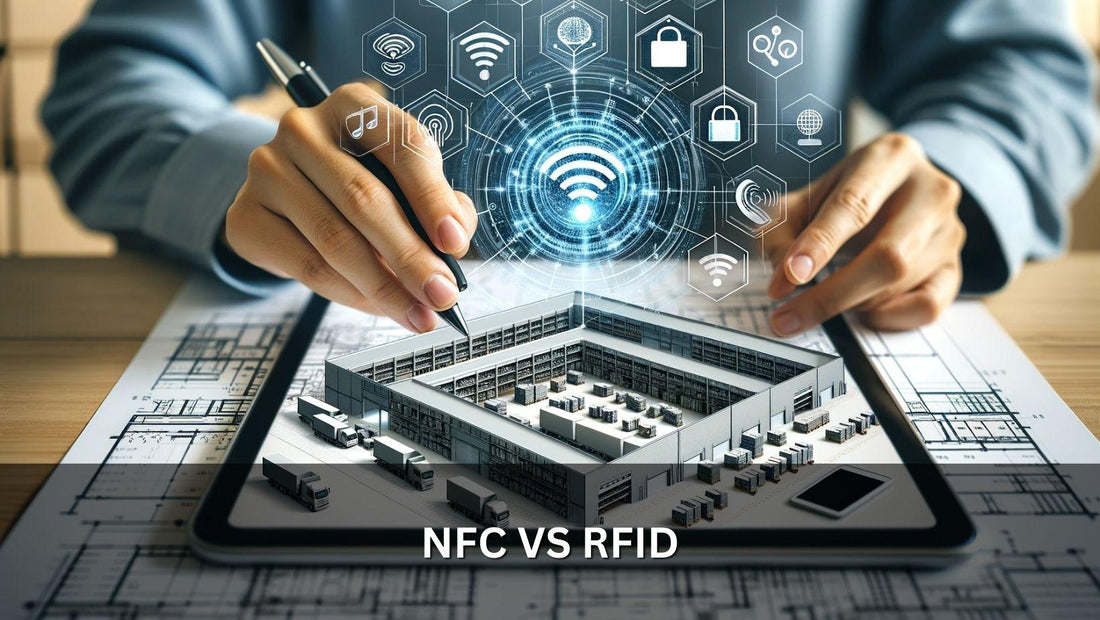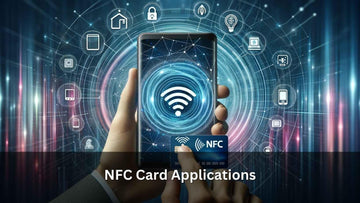NFC vs RFID

Contents
RFID vs NFC: Comparing Two Warehouse Management Technologies
In the dynamic world of warehouse management, the utilization of smart technologies like Radio Frequency Identification (RFID) and Near Field Communication (NFC) has become pivotal. These technologies, while seemingly similar, offer distinct features and capabilities that cater to diverse needs within a warehouse environment.
This article delves into the intricate aspects of RFID and NFC, comparing their functionalities, applications, and the unique roles they play in enhancing warehouse operations. By examining the nuances of these two technologies, we aim to provide a comprehensive understanding, aiding businesses in making informed decisions about which technology best suits their operational requirements.
RFID and NFC: A Technological Overview
Radio Frequency Identification (RFID) and Near Field Communication (NFC) represent two pillars of wireless communication technologies, widely used in varying applications, notably in warehouse management. RFID, a seasoned technology, operates by using radio waves to identify and track tags attached to objects. It consists of two main types: passive RFID, which draws power from the reader's signal, and active RFID, equipped with its own power source for greater range and reliability.
NFC, a subset of RFID, specializes in short-range communication, typically within a few centimeters. It facilitates secure, two-way interactions between electronic devices. While RFID excels in tracking and inventory management over longer distances, NFC's proximity requirement offers an added layer of security, making it ideal for tasks like access control and secure data transfer. Both technologies employ electromagnetic fields but differ significantly in range, data storage capacity, and power consumption, each serving unique operational needs in warehouse environments.
Understanding RFID Technology: RFID Tags in Detail

To seamlessly integrate the reference from RFID Global Solution's 2023 report into your existing paragraph, it can be added towards the end, providing a broader context on the advancements and applications of RFID technology in warehouse management. Here's how it could be incorporated:
RFID technology is underpinned by its tags, which are central to its functionality in warehouse management. These tags store data that can be read by RFID scanners. The versatility of RFID tags is evident in their two primary forms: passive and active.
Passive RFID tags, powered by the scanning antenna, are cost-effective and widely used for tracking inventory due to their simplicity and lower cost. Active RFID tags, on the other hand, contain their own power source, usually a battery, enabling them to transmit data over longer distances and store more information, making them suitable for larger warehouses and more valuable assets. Each type offers unique benefits, allowing businesses to tailor the technology to their specific operational needs.
Moreover, according to RFID Global Solution's report on 'Technology Trends and RFID in 2023', these tags not only enhance inventory management but also support sustainability initiatives. They enable the tracing of products through their full asset lifecycle, aligning with current trends that prioritize efficient and environmentally responsible business practices.
Passive RFID Tags
Passive RFID tags, devoid of internal power sources, rely on electromagnetic energy transmitted from RFID readers. Ideal for short-range tracking, they are cost-effective and durable, extensively used for inventory management in warehousing. Their simplicity and long lifespan make them a practical choice for bulk tracking of goods.
Active RFID Tags
Active RFID tags are equipped with a built-in power source, typically a battery, enabling them to transmit signals over greater distances. This feature enhances their utility in large-scale warehouse environments, allowing for real-time location tracking of high-value assets. Their enhanced functionality, however, reflects in a higher cost compared to passive tags.
NFC Tags: Powerhouses of Short-Range Communication
NFC tags represent a breakthrough in short-range communication, operating within a few centimeters to facilitate secure data exchanges. These small, wireless devices are embedded with chips that allow them to communicate with NFC-enabled devices, like smartphones or NFC readers.
Commonly used in contactless payment systems, NFC tags are gaining traction in warehouse management for tasks requiring proximity-based interactions, such as verifying the authenticity of goods or enabling quick access to product information. Their low cost, ease of programming, and ability to support encrypted data make NFC tags an invaluable tool in modern warehouse operations, complementing the broader range capabilities of RFID.
Key Differences Between RFID and NFC
While RFID and NFC stem from the same technological family, their key differences lie in range, functionality, and application. RFID, known for its versatility, offers a wider range of up to 100 meters, making it ideal for large-scale inventory tracking. In contrast, NFC operates within a 4 cm range, fostering secure, two-way communication.
Another notable distinction is in data transfer; NFC enables peer-to-peer exchange, which RFID lacks. These differences make RFID suitable for broader, long-distance applications, whereas NFC excels in close-proximity interactions, requiring more secure and targeted data sharing, such as in payment systems or sensitive information exchange. According to an article by ID&C, while RFID operates over multiple distances, NFC is specifically designed for secure, close-range transactions, underscoring its prevalent use in smartphones for applications like contactless payments
The Role of RFID in Warehouse Management

RFID technology has revolutionized warehouse management, offering an efficient solution for tracking and managing inventory. Its ability to quickly scan multiple items simultaneously drastically reduces the time needed for inventory audits. RFID tags attached to products or pallets enable real-time location tracking, significantly enhancing the accuracy of inventory records.
This technology also aids in automating the check-in and check-out processes, reducing human error and increasing operational efficiency. Additionally, RFID's integration with warehouse management systems allows for better forecasting and stock level optimization, contributing to a streamlined supply chain and improved overall productivity in warehouse operations.
Exploring NFC in Warehouse Management
NFC technology, with its short-range communication capabilities, is carving a niche in warehouse management. Primarily used for tasks that require a higher level of security and precision, NFC is ideal for validating the authenticity of high-value items and managing access control.
Its ease of use, enabled by simple tap-and-go interactions, streamlines processes like equipment checkouts and inventory audits. NFC also facilitates quick data retrieval from tagged items, enhancing the efficiency of picking and packing operations. As warehouses increasingly adopt smart technologies, NFC stands out for its ability to offer secure, user-friendly, and interactive solutions in a compact, cost-effective format.
RFID vs NFC: Is a Choice Required?
Choosing between RFID and NFC isn't always a matter of one over the other; instead, it can be about leveraging their strengths in tandem. While RFID offers broader range tracking, NFC excels in secure, close-range interactions. The decision often hinges on specific operational needs, suggesting a complementary rather than exclusive use of both technologies in many warehouse scenarios.
Challenges and Limitations of RFID and NFC Technologies
Both RFID and NFC face challenges, such as interference issues, high costs for active RFID systems, and NFC's limited range. Environmental factors can impact RFID's efficiency, while NFC's requirement for proximity can restrict its use cases. Balancing these limitations with their benefits is crucial for effective implementation.
According to RFID Card, another significant challenge for RFID technology is security, particularly for passive tags that are susceptible to malicious attacks like spoofing and eavesdropping, highlighting the need for heightened security measures in RFID deployment
Future Trends in RFID and NFC Technologies
The future of RFID and NFC points towards greater integration with IoT, enhanced data analytics, and improved security features. Advancements in miniaturization and cost reduction are expected, potentially expanding their applications. The convergence with AI and cloud computing could also see these technologies playing a pivotal role in smart warehouse automation.
FAQ
How Secure Are RFID and NFC Technologies?
Both RFID and NFC offer security features, but NFC's short-range communication inherently provides a higher security level. Encryption and secure authentication methods are commonly employed in both technologies to safeguard data.
What Types of Objects Can RFID and NFC Tags Be Attached To?
RFID and NFC tags are versatile and can be attached to a wide range of objects, from small retail items to large industrial equipment, enhancing tracking and data collection.
Can RFID and NFC Technologies Be Integrated with Other Warehouse Management Systems?
Yes, both RFID and NFC technologies can be seamlessly integrated with existing warehouse management systems, facilitating data synchronization and real-time inventory tracking.
RFID vs NFC: Which is Better for My Operations?
The choice depends on specific operational needs. RFID is ideal for long-range tracking and bulk scanning, while NFC is suited for secure, close-proximity interactions. Understanding your operational requirements is key to selecting the right technology.
How Secure Are RFID and NFC Technologies?
RFID and NFC incorporate security protocols and encryption to prevent unauthorized access, with NFC offering enhanced security due to its proximity requirement.
What Types of Objects Can RFID and NFC Tags Be Attached To?
RFID and NFC tags can be attached to a diverse array of objects, from small retail products to large containers, facilitating versatile tracking and data management.
Can RFID and NFC Technologies Be Integrated with Other Warehouse Management Systems?
Yes, both RFID and NFC technologies can be integrated with various warehouse management systems, enhancing data accuracy and operational efficiency.
RFID vs NFC: Which is Better for My Operations?
The choice between RFID and NFC depends on specific needs: RFID for long-range, bulk tracking, and NFC for secure, close-range interactions.
Conclusion
In summary, while RFID and NFC have distinct characteristics and applications, both technologies are invaluable in modern warehouse management. The choice between them depends on specific operational requirements.
Embracing these technologies can significantly enhance efficiency, security, and data management in warehouse operations, steering businesses towards a more automated and intelligent future.
We at NFC Tagify provide all sort of NFC Solutions or you may contact us: Tel. 01600800080, Email: info@nfctagify.com









